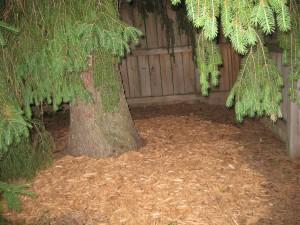Countdown to NaNo: Your Writing Space
 I love being a writer. What I can’t stand is the paperwork. —Peter De Vries
I love being a writer. What I can’t stand is the paperwork. —Peter De Vries
In 2009, The Guardian ran a wonderful feature called writer’s rooms. In the articles, writers talk about where they write. Even better, there are pictures! Here are some places that famous writers have found to be inspiring:
*Michael Morpurgo tried writing at a standing desk, like his friend and neighbor Ted Hughes, but it just made his feet hurt. After learning that Robert Louis Stevenson wrote on a bed, he took up the practice. He now has a study complete with a bed made just for his writing.
*Justin Cartwright writes in a former entrance to a builder’s yard, just 10 feet from his home. He likes to work in a separate space. In the office, he has big comfortable couches for napping. The author writes his novels in longhand, revises by hand, and then types them into the computer.
*Miranda Seymour writes on an old desk in the corner of her bedroom. Above her desk, she has placed photographs to inspire her writing. She also has a window nearby, so she can watch the birds.
Your Writing Space. Where will you write your National Novel Writing Month Project? Many of my colleagues write books at their neighborhood coffee shops, libraries, and restaurants. Others have spaces in their homes that they have claimed for their writing. I’ve always wanted to write under the big tree in our backyard, pictured above. If you are trying to write 50,000 words in November, I encourage you to do both. Find a public spot in your neighborhood where you can write without interruption. And, take time to clear out a space to write at home.
Before the month starts, clean up your home writing space so that you will be ready to write like a mad! Two years ago, I interviewed Organizer Regina Leeds, author of One Year to An Organized Life, about how to clean up one’s writing space. She said, “Walk away from your home office and return with what I call Fresh Eyes. See it as if for the first time.”
Ask yourself these questions. (You might want to make a list of your answers.):
- What tools and papers do you regularly need and waste time searching for?
- What stuff is in between your workspace and the tools you need?
- What other items get in the way of you doing your work?
- Are you constantly getting up to use items like the printer or fax that reside across the room?
Once you have this information, you need to set aside two uninterrupted hours to do a quick toss and reorganize. Here’s how:
1. Gather supplies. You will need a timer and four containers labeled:
- Toss. This is a trash container.
- Recycle. This is for your papers.
- Donate. This is for books and other items that you will donate.
- Move. Items you want to keep in your life but not in your writing space.
2. Do a speed elimination. Set a timer for 20 minutes. Choose one area of your writing space and eliminate everything that you identified in your list as being in your way. Use your containers! Repeat this as necessary—saving 40 minutes to do step three.
3. Move furniture, technology, and tools into the optimum positions.
4. Get the containers (and the stuff inside them) to their proper place!
5. Put any items you will need for National Novel Writing Month near your writing desk.
Now congratulate yourself! In two hours you have set up a great foundation for getting organized. You are so going to rock NaNoWriMo!









Probably the most fun part about preparing for NaNoWriMo (at least, for me) is cleaning up my writing space!